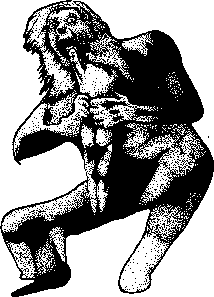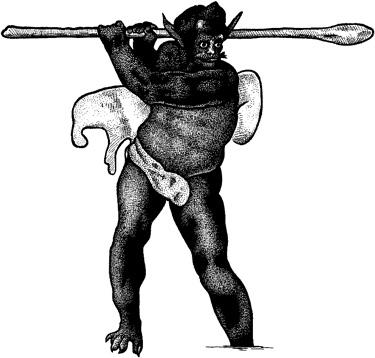


Berak-tal is a Spolite deity, the Ancestor of Ogres in the Carmanian region. The ogres of Berak-tal are clannish, and find sentient beings the most delectable of delicacies. They gain some small benefits in health and strength from the practice of cannibalism.
Mythos and History
When the Sun had been slain by Somathus, when the living and the dead mixed because the way to the underworld hadn’t yet been found, Berak-tal and her family were starving. The grains would not grow, the domesticated animals had all been eaten, and prey animals disappeared.
 Berak-tal tried to eat the bodies of the dead, but they provided no nutrition, and gave her the belly-gripe in the bargain. Then one day a Stranger God appeared. His eyes glowed blue, and he had horns on his head that resembled those of the big-headed ram. Berak-tal and her family were nearly dead from hunger, and they fell on the stranger with the only weapons they were able to lift – their hands and teeth. The blood of the Stranger God filled their mouths, and they found that the hunger was banished. They slaughtered the Stranger God with nothing more than the weapons nature had given them, eating his flesh and drinking his ichor raw.
Berak-tal tried to eat the bodies of the dead, but they provided no nutrition, and gave her the belly-gripe in the bargain. Then one day a Stranger God appeared. His eyes glowed blue, and he had horns on his head that resembled those of the big-headed ram. Berak-tal and her family were nearly dead from hunger, and they fell on the stranger with the only weapons they were able to lift – their hands and teeth. The blood of the Stranger God filled their mouths, and they found that the hunger was banished. They slaughtered the Stranger God with nothing more than the weapons nature had given them, eating his flesh and drinking his ichor raw.
The essence of the Stranger God not only filled their bellies, it gave them powers of mutability and movement. They found that they could change their shape, run over water, and leap great distances. But as they became hungry once again, they found that their new-found powers faded. Once again, just as they were about to starve to death, another Stranger God appeared at their door. This god had great teeth, and claws on his hands. His skin was armored like that of an armadillo. This time the family did not hesitate, but attacked the stranger god. Even with his formidable natural weapons, the stranger was overwhelmed and consumed.
Again, they gained great powers, but those powers faded as the ache in their bellies grew. No other gods appeared at their door, but one day a neighbor appeared. The thought of eating a neighbor was repugnant, but not enough to forestall the family from eating the neighbor. While they did not gain great powers from the neighbor, they still found that they gained some powers. From that point on, the family of Berak-tal preyed on their neighbors. They ate everything around them, but found that the most delicious meals were those where the meat was sentient and had magical powers.
When the Sun rose again, the family of Berak-tal found that their ability to absorb powers from their meals was a great benefit to their survival, but that their neighbors were wary. The powers of Shapeshifting that the family had learned from the first Stranger God were used to great effect to lull their prey’s vigilance.
Nature of the Cult
Berak-tal is the Ancestor of Ogres in Carmania. From her loins sprang the race of Ogres, and her worship gives them powers of darkness and mutability. Berak-tal is worshipped with sacrifice. Worshippers of Berak-tal often run inns or guest-houses, from which they are able to select victims. Others live far from the beaten path, waylaying strangers in the woods and hills that they know so well.
Depiction
Berak-tal is simply shown as a pair of fangs in the darkness. Family shrines are hidden from public view, often in caves or cellars, where the darkness shelters them.Rune Affinities
Berak-tal is associated with the Darkness and Movement/Change runes Darkness Rune Affinity
Darkness Rune Affinity
The Darkness rune hides the families of Berak-tal from their enemies and their prey. Berak-tal initiates can use the Darkness rune to: Hide in shadows, Startle Prey, There-Not There, Quench light
 Movement Rune Affinity
Movement Rune Affinity
Berak-tal gained the movement rune from the first Stranger God. With it her descendants may: Leap great distances, Move silently, Run over water, Cling to any surface, Slam door shut from across the room.
Particular Likes and Dislikes
When the Lightbringers came to Spol, the habit of Berak-tal to eat guests brought her family into conflict with the worshippers of Orlanth, whose notion of hospitality means not eating your houseguests. As a result, Berak-tal families will cheerfully kill Orlanthi whenever they see them. Of course, this has rarely been a problem since the fall of the Second Council.Other types of ogres are fair game for Berak-tal, and they get an even better benefit from eating an ogre than they do from a normal human.
Cult Organization
Berak-tal is a family goddess. Families are led by matriarchs. The children of the matriarch obey her without question – she is not only their priestess, she is also their mother or grandmother!There is no higher organization than the family.
Priestesses
The family matriarch leads worship services to Berak-tal. Priestesses are called “Mom”, Mother”, “Grandma”, “Ma’am” and the like.Center of Power, Holy Places
The home of Berak-tal is unknown –she moved her family away from it when she ate the last neighbor. Some matriarchs are actively searching for the Home.Holy Days
Each season has a holy day on Darkness Day of Movement Week. The High Holy Day is the holy day of Darkness Season.Sacrifices
The brain and heart of every victim is given to Berak-tal, and on Her High Holy Day a family must sacrifice at least three strangers to her.Initiates
Initiates who are born into the family approach Berak-tal through either the Darkness or Movement rune. Those that are forcibly married into the family may only approach her through the movement (Change) rune.Children are lay members of Berak-tal when they are born. They are raised on the flesh of humans and other sentient beings. When they reach puberty, they are initiated into the cult.
Members of the cult will sometimes kidnap members of the opposite sex in order to marry them and ensure the survival of the family. Kidnap victims will be force-fed cannibalistic meals until they join in willingly. At this point, they are initiated and married into the family in the same ceremony. They will always be second-class family members, however, usually mistreated by the matriarch, if not their own spouse as well.
Subcults
There are no formal subcults of Berak-tal, though each family of ogres has its own magics and stolen abilities.Devotees

Devotees of Berak-tal are rare, perhaps one in a family each generation. They are usually the superlative provider for the family, bringing in food by stealth and deception, or by actively hunting it in the wilderness.
Feats
 The Innocent House Feat
The Innocent House Feat
Even while Berak-tal was eating her neighbors, she managed to keep the secret from her neighbors. Her house was always spotless – no scattered bits of flesh or bloody cleavers appeared anywhere that a guest could see them. Use of this feat allows a worshipper to clean a house or other place so that all evidence of their dietary habits is gone. Blood splatters and butcher’s cutlery glow darkly, showing its location show it can be cleaned or hidden. If something can’t be moved, a veil of darkness will hide it from sight.
 The Get In Front Of You Feat
The Get In Front Of You Feat
Berak-tal’s son, Horvin-tal, was always able to get ahead of his prey and ambush it, even if his prey had managed to get far ahead of him. This feats allows the user to use his knowledge of the local land, movement magic, and a bit of authorial hand-waving, to get ahead of a fleeing victim and ambush her. It may also affect the victim with broken shoes, losing her way in the woods, etc.
 The One Always Survives Feat
The One Always Survives Feat
Unless the victims can make absolutely sure that all the worshippers of a Berak-tal family are dead, one will survive to plague future travelers through their land. Unless rendered fully and irrevocably dead, it will be the matriarch or a devotee.
Notes
Cult Families
Berak-tal families are incestuous, and new members are only brought in when there are no members of the appropriate gender in a generation. Such “incomers” are kidnapped, forced to eat human flesh, kept chained in deep holes, and mentally and physically abused until their mind snaps and they are willing to marry into the family and cult. Incomers often become the most ardent of Berak-tal cultists, and may eventually rise to the rank of Devotee or even Matriarch.Cultist’s Appearance
Some cultists are indistinguishable from normal humans, especially those that have married into the family. They are used as the “public face” when strangers come. Other members have a variety of genetic problems, including cleft palates, tumors, mismatched limbs, imbecility, etc. While some may look on these as “Chaos Features”, they are not, they are simply products of generations of inbreeding.Cultist’s Abilities
Cultists are Gloranthan Ogres, as defined by your particular set of rules. In general, this means that they are stronger and more robust than normal humans. The Movement/Change rune grants them some power to physically change their appearance, to appear “normal”. This is not illusion magic – their body physically changes shape. It is quite painful both when this type of magic is cast, and when it wears off and the body returns to its original form. Families out in the wilderness tend to be quite proficient hunters, using darkness magic to confuse prey, and movement magic to run it down. Berak-tal families who run guest-houses are more likely to be good with hand to hand combat, usually using butcher’s tools, but able to use anything as a weapon in a pinch.Cannibalism and Acquired Powers
Worship of Berak-tal allows one to gain a small benefit when one eats a magic-using creature (not a magical creature such as a unicorn or pixie).First, eating sentient creatures keeps the hunger at bay. Eating At least one sentient creature a season ensures that a cultist’s normal Ogre abilities remain in top form. Eating fewer than one sentient a season means that the ogre suffers a penalty on “Ogre” powers, as well as all Berak-tal magic. A Berak-tal worshipper will never starve because he’s eating only non-sentient flesh, but he will become only as strong as a normal human.
Second, a worshipper gains a minor ability in all magic known by the victim. If the worshipper already has similar magic, he will gain a small bonus to it.
In Heroquest 2, this is modeled by using Rune abilities - for example, eating an Orlanthi yields minor abilities in Storm and Mastery, and a bonus to your own Movement abilities.
In RuneQuest, it is modeled as a POWx1% chance of casting any Divine Magic spell known by the victim as a one-use spell.
These bonuses only last for about a week.
Eating a Spirit-user or Sorcerer yields no power – first because their magic is different than Berak-tal’s, and second because their magic is not innate, but is Book-learning (Sorcery) or simple Charms and trinkets (Animism). A worshipper of Berak-tal may, however, have quite an arsenal of spirit charms stolen from victims, and old families may have libraries of traveler’s Grimoires.





